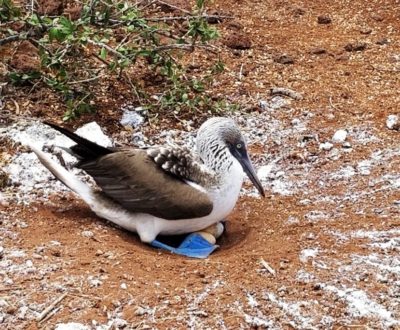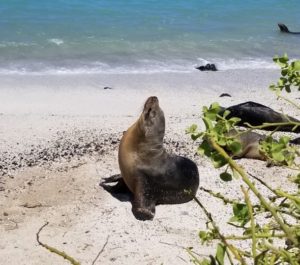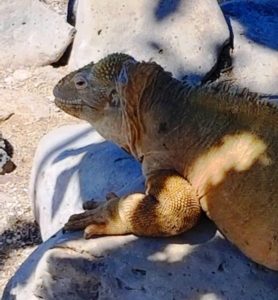A Veterinarian’s View of the Galapagos Islands

A Veterinarian’s View of the Galapagos Islands
I was very lucky last month to have fulfilled a long-held desire to go to the Galapagos Islands. The desire stemmed from my general love of animals, a presentation on the giant tortoises I attended while in veterinary school and a biographical novel featuring Charles Darwin. The sea turtles, frigate birds, blue footed boobies and dolphins I saw in the archipelago did not disappoint, but I found some of the other aspects of the trip even more fascinating.
Flying, floating or swimming
I was under the mistaken impression that the fourteen Galapagos Islands had at one time been part of a larger land mass and that the unique species on the islands had evolved because they were isolated by continental drift. Wrong! The Galapagos Islands are volcanic – like Hawaii. Any animals on the island arrived by either by flying, floating on a mass of seaweed or swimming from South America. This means the islands lack terrestrial mammals that cannot swim long distances or fly. Any mammals on the islands hitchhiked with humans and are considered invasive species. Invasive mammals common to the Galapagos include dogs, cats, rodents and goats.

A job with Darwin?
The Galapagos Islands are loaded with scientists. They work out in the field and at the Charles Darwin Research Station (CDRS) on Isla Santa Cruz. Most tours of the Galapagos include a trip to the research station where you can see several species of tortoise, each from a different island. The different species can be identified by their different shaped shells. The station also has a tortoise nursery where vulnerable baby tortoises are safely raised until they can be returned to the wild in an attempt to repopulate the islands. Visitors to the research station can also observe a large number of iguana species in residence. The whole place is so inspiring that I would be happy to label specimens in a CDRS laboratory for the opportunity to contribute to this important work.

The delicate balance between cactus, iguanas, hawks and humans
Just by chance, our tour group ran into a scientist. He spoke about his work studying the declining cactus population on one specific island. Studying archival photographs of the island, this researcher tracked the dwindling cacti population and also noticed there are no replacement cacti springing up. The researcher hypothesized that this is due to the island’s unchecked population of iguana, whose favorite meals include cactus fruit. Too many iguanas and too few cacti will ultimately lead to a crisis. The solution: plant more cactus? Iguana birth control? The answer is neither. The island is also devoid of iguana predators, namely the Galapagos hawk. So, to improve the health of the cactus and iguanas, the island needs a hawk to two to control the iguana population which will in turn allow new cactus growth. Hawks are in short supply because they eat chickens, and that doesn’t sit well with local farmers. This type of ecological problem is considered a One Health problem, the kind of scientific quandary I find most fascinating. The concept of One Health recognizes the interconnection between people, animals and their shared environment and understands the health of one impacts the health of all. This trip didn’t really satisfy my desire to visit the Galapagos Islands; it only fueled the desire for a second visit.






























